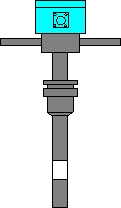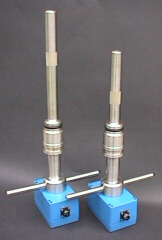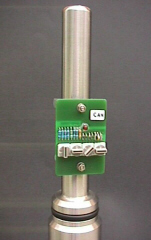
Digitrans Industrial Controls
Description of the Analog
Probe
The Digitrans Analog RF Probe was developed from the Digitrans Digital RF Probe. The digital probe is used wherever precise Brix values are required. It is particularly useful in high purity solutions as found in refineries. The digital probe with its microprocessor controller will give very accurate Brix readings (+/- 0.1Bx) provided care is taken with the calibration procedure. This can be rather time consuming and requires a degree of skill in sampling technique and care in entering the data. For those applications that do not require a precise numerical Brix value a simpler probe was developed that would give an output suitable for pan control but that would be easy to calibrate. This development resulted in the analog probe.

Analog probes.
PRINCIPLE OF OPERATION
The tuned circuit of an oscillator is coupled to the probe electrode and changes in composition of the solution cause changes of the resonant frequency of the tuned circuit. The shift in frequency is converted to an analog voltage which controls the 4-20mA current loop. The analog probe uses only a single measurement frequency of 18MHz. which responds to both capacitance and conductivity changes. This makes its field of application mainly in low purity solutions. It is not suitable for use in refineries.
DESCRIPTION
The probe body is identical to the digital probe which is illustrated in the accompanying pamphlet. The analog probe does not require an additional controller, all the electronics being housed in the aluminium box mounted at the head of the probe. The only visible difference between the digital and analog probes is the connector. The digital probe has a coax connector while the analog probe has a multi pin circular connector. The analog probe is fitted to the process vessel by the same bronze mounting socket as the digital probe which means that the two models may be interchanged. The electronics has a very low power drain which enables it to be powered from the 4-20mA loop. Thus only two wires are required to connect the probe. No local display is provided.. The only two controls that may be adjusted on the probe are zero and span. These are set by screwdriver adjusted multiturn potentiometers inside the box. (See calibration) The entire circuit is encapsulated in epoxy resulting in an extremely rugged instrument.
APPLICATION
The analog probe is used in many situations in raw sugar factories. It can be used in syrup, batch pans and continuous pans
CALIBRATION
The probe is calibrated on the bench before being installed in the process. Calibration is a simple two point adjustment of zero and span. The two adjustments are non interactive. A calibrator, which is a switch selectable array of resistors and capacitors, is clipped onto the probe electrode to simulate the impedances corresponding to the high and low brix ranges. The switch settings for the low brix value are read off a chart provided for the appropriate substance.(massequite,syrup etc.) The switches are set to these values and the zero potentiometer adjusted for 4mA. The switches are then set for the high brix value and the span potentiometer is adjusted to give 20mA. The probe is then ready for service. Calibrators are supplied as separate items.

Calibrator attached to probe.
SPECIFICATION
Models There is one standard length model of 250mm wetted length. Special sizes may be supplied on request.Home